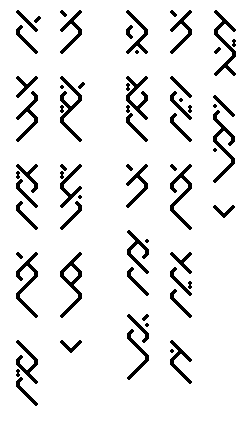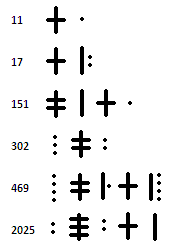Kala writing: Difference between revisions
From FrathWiki
Jump to navigationJump to search
m (→Naua) |
mNo edit summary |
||
| Line 1: | Line 1: | ||
{{Kala 2}} | {{Kala 2}} | ||
[[File:Kita naua.png]] | [[File:Kita naua.png]] | ||
= Naua = | = Naua = | ||
| Line 31: | Line 26: | ||
= Moyato = | = Moyato = | ||
* ''' | * '''moyato''', meaning "How to write." An example of the formation of words based on the above graphemes. | ||
[[File:Naua paka.png]] | [[File:Naua paka.png]] | ||
| Line 38: | Line 33: | ||
# The graphemes for '''pa''' and '''ka'''. | # The graphemes for '''pa''' and '''ka'''. | ||
# Combining these renders '''pak'''. | # Combining these renders '''pak'''. | ||
# Adding a ''' | # Adding a '''koli''', or "tail" renders '''paka'''. | ||
# Diacritic marks for /e/ and /o/ render '''peko''' /ˈpeː.ko/. | # Diacritic marks for /e/ and /o/ render '''peko''' /ˈpeː.ko/. | ||
* Bottom row, left to right. | * Bottom row, left to right. | ||
# Marks the labialization of /p/; /ˈpʷaː.ki/ | # Marks the labialization of /p/; /ˈpʷaː.ki/ | ||
# Shows the palatalization of /k/ and demonstrates two diacritics on one glyph; /ˈpaː.kʲo/, ''' | # Shows the palatalization of /k/ and demonstrates two diacritics on one glyph; /ˈpaː.kʲo/, '''pakyo'''. | ||
# The [[ | # The [[Wikipedia:Prenasalized_consonant|nasalization]] mark is shown on the '''ka''' syllable to render /ˈpunː.ka/ or /ˈpuŋː.ka/, '''punka'''. | ||
# The nasalization mark is shown on the initial glyph and demonstrates two diacritics on one glyph; /ˈᵐpoː.ka/, ''' | # The nasalization mark is shown on the initial glyph and demonstrates two diacritics on one glyph; /ˈᵐpoː.ka/, '''mpoka''' | ||
== kasi == | == kasi == | ||
* The conventional link between glyphs does not always occur. There are eight constructions which use the ''' | * The conventional link between glyphs does not always occur. There are eight constructions which use the '''koli''' to link glyphs that do not fit together in the standard way. | ||
[[File:Naua kasi.png]] | [[File:Naua kasi.png]] | ||
# When linking '''sa''' with '''ta''' and '''ka''' a ''' | # When linking '''sa''' with '''ta''' and '''ka''' a '''koli''' '''yomo ua'e ka'e yoso tahe''' [right up to left down] is used. The same construction is used when linking '''ha''' with '''ta''' and '''ka'''. | ||
# When linking '''la''' with '''na''' and '''nya''' a ''' | # When linking '''la''' with '''na''' and '''nya''' a '''koli''' '''yoso ua'e ka'e yomo tahe''' [left up to right down] is used. | ||
# When writing a word that begins with a vowel glyph that is followed by a '''na''' or '''nya''', a ''' | # When writing a word that begins with a vowel glyph that is followed by a '''na''' or '''nya''', a '''koli''' '''yoso ua'e ka'e yomo tahe''' is used instead of the [[Wikipedia:Zero_consonant|zero consonant]] symbol. This is the only occasion that a '''koli''' will be marked with a vowel diacritic. | ||
= Numerals = | = Numerals = | ||
| Line 79: | Line 74: | ||
= Universal Declaration of Human Rights = | = Universal Declaration of Human Rights = | ||
[[File:Naua udhr.png|frame|The [[ | [[File:Naua udhr.png|frame|The [[Wikipedia:Universal_Declaration_of_Human_Rights|UDHR]] in '''naua moya'''.]] | ||
[http://sanoajat.webs.com/udhr.wav Sound Sample] | [http://sanoajat.webs.com/udhr.wav Sound Sample] | ||
Revision as of 07:26, 13 November 2012
Naua
- naua moya is an adaptation of Ajan for writing Kala.
- naua moya is written vertically, in columns running from left to right, but can be written horizontally.
Consonants
Diacritics
Basic strokes
stroke direction
Moyato
- moyato, meaning "How to write." An example of the formation of words based on the above graphemes.
- Top row, left to right.
- The graphemes for pa and ka.
- Combining these renders pak.
- Adding a koli, or "tail" renders paka.
- Diacritic marks for /e/ and /o/ render peko /ˈpeː.ko/.
- Bottom row, left to right.
- Marks the labialization of /p/; /ˈpʷaː.ki/
- Shows the palatalization of /k/ and demonstrates two diacritics on one glyph; /ˈpaː.kʲo/, pakyo.
- The nasalization mark is shown on the ka syllable to render /ˈpunː.ka/ or /ˈpuŋː.ka/, punka.
- The nasalization mark is shown on the initial glyph and demonstrates two diacritics on one glyph; /ˈᵐpoː.ka/, mpoka
kasi
- The conventional link between glyphs does not always occur. There are eight constructions which use the koli to link glyphs that do not fit together in the standard way.
- When linking sa with ta and ka a koli yomo ua'e ka'e yoso tahe [right up to left down] is used. The same construction is used when linking ha with ta and ka.
- When linking la with na and nya a koli yoso ua'e ka'e yomo tahe [left up to right down] is used.
- When writing a word that begins with a vowel glyph that is followed by a na or nya, a koli yoso ua'e ka'e yomo tahe is used instead of the zero consonant symbol. This is the only occasion that a koli will be marked with a vowel diacritic.
Numerals
- In large numbers, elements are combined from largest to smallest, and zeros are implied [see example "302" to the right].
-
Universal Declaration of Human Rights

The UDHR in naua moya.
- kua tlana tsiya ma’a katsi ma kueli itlo nasa
- all human free with dignity and rights equal born
- All human beings are born free and equal in dignity and rights.
- kam tlitsi ma toya yoha ma kanku ma’a tsaku te takun ketahe
- 3PL reasoning and conscience possess and 3PL.RECP with idea of brotherhood behave.NEC
- They are endowed with reason and conscience and should act towards one another in a spirit of brotherhood.








